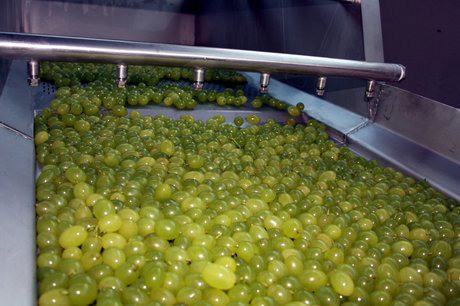Commercially packaged table grapes that are stored in clusters in perforated packaging have generally a short shelf-life (8-10 weeks), which can vary greatly with storage conditions and grape variety. The shelf-life of grapes is often shortened by weight loss, stem browning, softening, shattering, and decay.
The standard method to control postharvest decay of cluster grapes is to fumigate with sulphur dioxide gas the fruit immediately after harvest and during storage. However, the concentration of sulphur dioxide necessary to inhibit fungal infections may induce injuries in both rachis and berries, in addition sulphur dioxide application has been restricted in many Countries for the human health risks due to the sulphite residues. Several studies have shown the efficacy of heat treatments on harvested fruits to control biological agents, delay ripening and preserve quality of fresh-cut table grapes.

A study by UC Davis researchers
The objective of the study conducted by Kou et al. (2009) on table grape was to optimize a treatment for cluster grapes as alternative to sulphur dioxide to maintain the berries quality. For the work, cv ‘Crimson’ was used, the grapes were prepared using the following two methods:
- the rachis of the grapes was removed so that the grapes retained 1 to 2 mm of pedicel;
- the rachis and the pedicels of cluster grapes were kept intact and the grapes remained on the original cluster.
- short-stem grapes receiving chlorine and hot water treatment;
- short-stem grapes receiving chlorine wash and no hot water treatment;
- cluster grapes receiving chlorine and hot water treatment;
- cluster grapes receiving chlorine wash but no hot water treatment;
- cluster grapes receiving no chlorine but hot water treatment;
- cluster grapes not receiving either chlorine wash or hot water treatment;
- commercially packed cluster grapes.
For chlorine wash, the samples were dipped in a sodium hypochlorite solution for 1 min followed by draining and air drying. For the hot water treatment, the samples were dipped in a water bath at 45°C for 8 min followed by draining and air cooling. In the first six treatments MAP (Modified Atmosphere Packaging) was used. After treatments, the samples were put into rigid polypropylene trays and sealed, then stored at 5±1 °C for up to 28 days with quality evaluation performed on days 0, 7, 14, and 28.
The results showed that oxygen pressure in the headspace of the packages decreased significantly during the storage, but this reduction was lower in the samples that received the hot water treatment. In these samples the CO2 accumulation and ethylene pressure in the headspace of the packages resulted lower than in the packages of samples without hot treatment. Dipping the samples in the hot water allowed to slow the metabolic processes of tissues.
The MAP allowed to delay senescence process and preserve the grapes firmness. Hot water at 45°C for 8 min significantly improved the firmness and visual quality of grapes, and reduced yeast and mold growth. Rachis removal combined with chlorine wash and MAP significantly extended the shelf-life and resulted beneficial to maintain the visual quality of table grapes. Chlorine wash treatment was fundamental to control microbial population.
The synergy among these four treatments (rachis removal, chlorine wash, hot water treatment, and MAP) allowed to maintain an excellent visual quality throughout the entire storage period, whereas the commercially packaged grapes became decayed and their visual quality reached unacceptable level. This treatments combination resulted effective to reduce microbial spoilage, prevent dehydration and delay softening and senescence of grapes.
Original research. Kou L., Luo Y., Ding W., Liu X., Convay W., "Hot water treatment in combination with rachis removal and modified atmosphere packaging maintains quality of table grapes", 2009, HortScience, Issue N. 44(7), pagg. 1947-1952. More details: ucce.ucdavis.edu/files/datastore/234-1708.pdf








